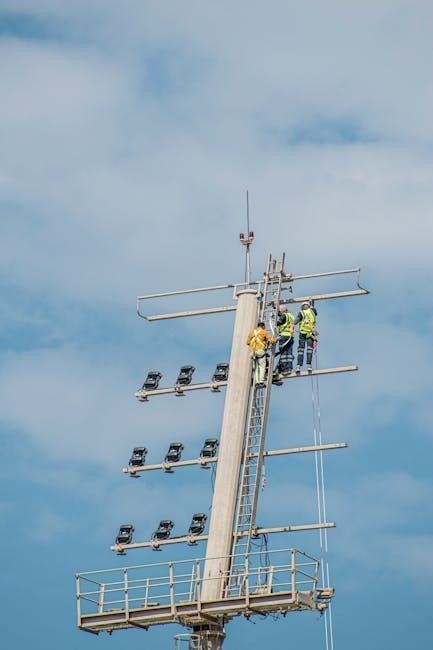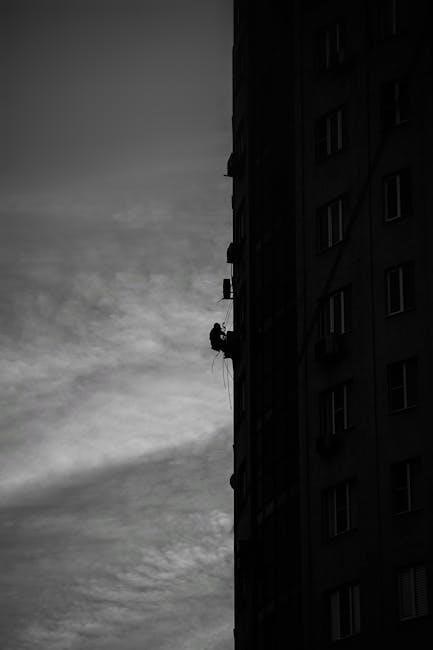
-
By:
- otis
- No comment
risk assessment for working at height pdf
Working at height involves tasks where a fall could cause injury. Risk assessment is crucial to minimize risks, ensuring safety protocols and control measures are effectively implemented.
1.1 Definition of Working at Height
Working at height refers to any task where a fall could cause injury, even if the distance is short. It includes activities on ladders, scaffolding, roofs, or any elevated surface where precautions are necessary to prevent falls. The key factor is the potential for a fall to result in harm, regardless of the height involved. This definition emphasizes the importance of identifying and managing risks associated with elevated work environments. Understanding this concept is crucial for implementing safety measures and ensuring compliance with regulations. It applies to various industries, from construction to maintenance, and is fundamental to creating a safe working environment.
1.2 Importance of Risk Assessment in Height-Related Tasks
Risk assessment is essential for identifying and mitigating hazards in height-related tasks. It ensures that all potential risks are evaluated, allowing for the implementation of appropriate safety measures. By conducting thorough assessments, employers can minimize the likelihood of accidents, protect workers, and comply with legal requirements. Risk assessment also helps in prioritizing risks, allocating resources effectively, and ensuring that control measures are proportionate to the hazards identified. Regular reviews of risk assessments are necessary to adapt to changing work conditions and maintain a safe environment. This proactive approach not only safeguards lives but also enhances operational efficiency and reduces potential liabilities.
Understanding Risk and Hazard
Risk is the potential for harm from hazards, varying from narrow to broad definitions. Hazard is any situation that could cause injury or damage, necessitating assessment.
2.1 Definitions of Risk and Hazard
Risk is defined as the possibility of harm or loss resulting from a hazard. It encompasses uncertainty about the effects of an activity, particularly negative consequences. A hazard, meanwhile, is any situation or condition that could cause injury or damage. In the context of working at height, hazards might include unstable surfaces, equipment failure, or poor weather conditions. Understanding these definitions is critical for effective risk assessment, as they form the foundation for identifying and mitigating potential dangers. By recognizing hazards and evaluating associated risks, employers and workers can implement appropriate safety measures to prevent accidents and ensure a safer working environment.
2.2 Narrow, Medium, and Broad Definitions of Risk
Risk can be defined in three ways: narrow, medium, and broad. Narrowly, risk refers to direct threats to people or machinery from hazards. Medium definitions expand this to include uncertainties affecting outcomes. Broadly, risk encompasses any uncertainty, whether positive or negative, tied to an activity’s consequences. In working at height, a narrow view might focus on falls, while a medium perspective considers equipment reliability, and a broad approach evaluates overall project uncertainties. Understanding these definitions aids in comprehensive risk assessments, ensuring all potential impacts are addressed, from immediate dangers to long-term operational uncertainties.

Legal and Regulatory Framework
Working at height is governed by specific laws and regulations ensuring safety. These frameworks outline mandatory precautions, risk assessments, and safety standards to protect workers from height-related hazards.
3.1 Overview of Relevant Laws and Regulations
Working at height is regulated by laws such as the Occupational Safety and Health Act and the Health and Safety at Work Act. These laws require employers to conduct thorough risk assessments and implement safe systems of work to protect employees from height-related hazards. Regulations emphasize the importance of minimizing risks through proper planning, equipment, and training. Compliance with these laws ensures that workplaces adopt standardized safety practices, reducing the likelihood of accidents. Employers must also maintain records of risk assessments and safety protocols, demonstrating their commitment to legal and regulatory standards. These frameworks are essential for safeguarding workers and ensuring accountability in height-related tasks.
3.2 Role of Safety Standards in Height-Related Work
Safety standards play a pivotal role in height-related work by providing clear guidelines for equipment, practices, and training. These standards ensure consistency and reliability across industries, reducing risks and enhancing worker safety. They outline specific requirements for fall protection equipment, such as harnesses and guardrails, and dictate proper installation and maintenance procedures. Additionally, standards like ISO and OSHA regulations offer frameworks for conducting risk assessments and developing emergency response plans. Compliance with these standards not only minimizes legal liabilities but also fosters a culture of safety within organizations. By adhering to established standards, employers can ensure that height-related tasks are performed safely and efficiently, protecting both workers and assets from potential harm.
The Risk Assessment Process
Risk assessment systematically identifies, evaluates, and prioritizes hazards to ensure safe working conditions. It involves analyzing tasks, environments, and equipment to mitigate potential risks effectively.
4.1 Identifying Hazards in Work at Height
Identifying hazards in work at height involves recognizing potential risks such as unstable surfaces, equipment failure, and environmental factors. A thorough inspection of the work area is essential to spot these dangers. For instance, uneven or slippery surfaces can lead to slips and falls, while faulty equipment like ladders or harnesses can malfunction, increasing the risk of accidents. Additionally, environmental conditions like strong winds or poor lighting can exacerbate hazards. By systematically assessing each component of the work environment, employers and workers can pinpoint specific risks and take proactive measures to mitigate them, ensuring a safer working environment.
4.2 Assessing the Level of Risk
Assessing the level of risk involves evaluating the likelihood and potential impact of identified hazards. This step requires analyzing factors such as the nature of the task, the condition of equipment, and environmental conditions. For example, a task performed at a greater height or on an unstable surface poses a higher risk. The assessment also considers the number of people exposed to the hazard and the potential severity of harm. By quantifying these elements, organizations can prioritize risks and determine the most effective control measures. This systematic approach ensures that resources are allocated efficiently to mitigate risks and safeguard workers. Documentation of the assessment process is crucial for accountability and future reference.
4.3 Evaluating and Prioritizing Risks
Evaluating and prioritizing risks involves determining which hazards pose the greatest threat and require immediate attention. This step ensures that resources are allocated effectively to address the most critical risks first. Risks are typically prioritized based on their severity and likelihood, often using a matrix that categorizes them as high, medium, or low priority. High-priority risks, such as those with a high likelihood of causing severe injury, are addressed first. This process also considers the feasibility of implementing controls and the cost-benefit analysis of different solutions. By systematically evaluating and prioritizing risks, organizations can create a focused action plan to enhance safety and reduce incidents. Regular reviews ensure that priorities remain relevant as conditions change.

Hierarchy of Controls
The hierarchy of controls is a framework to minimize risks by prioritizing elimination, substitution, engineering controls, administrative protocols, and PPE to ensure effective hazard mitigation in work at height.
5.1 Elimination of Hazards
Hazard elimination is the most effective control measure in working at height. It involves removing or avoiding risks entirely. This can be achieved by avoiding work at height where possible, using alternative methods like robotics or remote-operated systems, or redesigning equipment to reduce the need for elevated tasks. For example, selecting materials or tools that can be assembled at ground level before being lifted into place minimizes the need for workers to perform tasks at height. Elimination is not only the safest approach but also often the most cost-effective in the long term, as it reduces the need for complex safety protocols and equipment. Legal and safety standards strongly advocate for this method as the first line of defense against height-related risks.
5.2 Substitution of Hazardous Methods
Substitution involves replacing hazardous methods with safer alternatives to reduce risks in working at height. This step is crucial when elimination isn’t possible. For example, using scaffolding instead of ladders or implementing mechanical lifts to minimize manual handling at heights. Substitution also includes adopting advanced technologies, such as drones or robotic systems, to perform inspections or maintenance tasks without human exposure. By substituting dangerous practices with inherently safer ones, the likelihood of accidents is significantly reduced. This approach aligns with the hierarchy of controls, prioritizing safer methods to protect workers. Regularly reviewing and updating methods ensures that the safest practices are always in use, minimizing risks and enhancing overall safety outcomes.

5.3 Engineering Controls for Fall Prevention
Engineering controls are physical measures designed to prevent falls and protect workers at height. These include guardrails, safety nets, and fall arrest systems. Guardrails are barriers installed around edges to prevent falls, while safety nets provide a catch system below work areas. Fall arrest systems, such as harnesses and lanyards, stop a worker’s fall before impact. These controls are critical in high-risk environments where direct human error could lead to accidents. Proper installation, maintenance, and regular inspection of these systems ensure their effectiveness. Engineering controls are a key component of the hierarchy of controls, offering reliable protection when administrative or PPE measures are insufficient. They minimize risks and create a safer working environment for all employees engaged in height-related tasks.
5.4 Administrative Controls and Safety Protocols
Administrative controls and safety protocols are essential for managing risks in work at height. These include safety talks, toolbox meetings, and structured procedures to ensure compliance with safety standards. Key protocols involve permit-to-work systems, access restrictions, and clear communication of hazards. Supervisors must enforce safe work practices, monitor adherence, and address deviations promptly. These measures complement engineering controls by establishing a culture of safety and accountability. Regular reviews and updates to protocols ensure they remain effective. Administrative controls are vital for minimizing risks when engineering solutions are not feasible, ensuring all workers understand their roles in maintaining a safe environment. They are a cornerstone of proactive risk management in height-related tasks.
5.5 Use of Personal Protective Equipment (PPE)
Personal Protective Equipment (PPE) is a critical component in managing risks during work at height. Common PPE includes harnesses, lanyards, and helmets, designed to protect workers from falls and falling objects. Proper fitting and maintenance of PPE are essential to ensure effectiveness. Workers must be trained to use PPE correctly, including regular inspections and adherence to manufacturer guidelines. PPE should be selected based on the specific risks identified during the risk assessment process. While PPE is a vital safety measure, it should always be considered as the last line of defense after eliminating or controlling hazards through other means. Regular audits and updates to PPE protocols ensure ongoing protection and compliance with safety standards.
Fall Protection Equipment
Fall protection equipment, such as harnesses, lanyards, and anchor points, is essential for preventing falls and protecting workers during height-related tasks. Proper use and maintenance are critical.
6.1 Types of Fall Protection Gear
Fall protection gear includes harnesses, lanyards, anchor points, and safety nets. Harnesses distribute force across the body, while lanyards connect workers to secure anchors. Anchor points are fixed structures that provide a safe attachment point. Safety nets are used to catch falls in high-risk areas. Hard hats protect against falling objects, and retractable lanyards allow movement while maintaining a safe connection. Proper selection and use of this equipment are critical to ensuring worker safety during height-related tasks. Regular inspections and maintenance of fall protection gear are essential to guarantee its effectiveness in preventing injuries and fatalities.
6.2 Proper Use and Maintenance of Equipment
Proper use and maintenance of fall protection equipment are critical to ensuring worker safety. Before each use, equipment must be inspected for wear, tear, or damage. Harnesses, lanyards, and anchor points should be checked for signs of deterioration, such as frays or corrosion. Equipment should be stored in a dry, clean environment to prevent damage. Regular maintenance, as per manufacturer guidelines, is essential to extend the lifespan of the gear. Training on the correct use and inspection of equipment is vital to prevent accidents. Any damaged equipment should be immediately removed from service and replaced. Proper maintenance ensures that fall protection gear functions effectively in preventing injuries and fatalities during height-related tasks.
6.3 Rescue Plans and Emergency Procedures
Rescue plans and emergency procedures are essential for ensuring prompt and effective responses to falls or other incidents during work at height. A well-structured rescue plan should include clear steps for evacuating injured workers, providing first aid, and coordinating with emergency services. Regular training and drills are crucial to ensure that all team members understand their roles in an emergency. The plan should also account for the specific hazards of the work environment and the equipment available. Proper execution of rescue procedures can minimize the risk of further injury and ensure timely medical attention. Regular reviews and updates to the plan are necessary to adapt to changing work conditions and equipment advancements.

Safety Training and Awareness
Safety training is vital for reducing risks in height-related tasks. It equips workers with knowledge on equipment use, hazard identification, and emergency procedures, ensuring compliance and incident prevention.

7.1 Importance of Training in Height-Related Work
Training is essential for ensuring worker safety in height-related tasks. It equips individuals with the knowledge and skills to identify hazards, use equipment properly, and follow safety protocols. Proper training reduces the likelihood of accidents by fostering a culture of safety and awareness. It also ensures compliance with legal and regulatory requirements, protecting both employees and employers. Effective training programs cover risk assessment, fall prevention, and emergency response, empowering workers to make informed decisions. Regular updates and refreshers are crucial to maintain proficiency and adapt to new technologies or procedures. Ultimately, training is a cornerstone of a robust safety management system for working at height.

7.2 Key Topics in Safety Training Programs
Safety training programs for height-related work should cover essential topics to ensure comprehensive understanding. These include hazard identification, risk assessment methodologies, and the proper use of fall protection equipment. Participants should learn about safety standards, regulations, and industry best practices. Training also emphasizes emergency response plans, rescue techniques, and first aid for fall-related injuries. Understanding the hierarchy of controls, from elimination to PPE, is vital. Practical demonstrations and hands-on exercises are included to reinforce theoretical knowledge. Additionally, programs address safe work practices, equipment inspection, and maintenance. Regular updates on new technologies and procedures ensure workers stay informed. These topics collectively aim to enhance safety awareness and competence, reducing incidents and ensuring compliance with legal requirements.
Emergency Preparedness
Emergency preparedness involves developing response plans, first aid protocols, and rescue procedures for height-related incidents. Regular drills and clear communication ensure effective implementation during critical situations.
8.1 Developing an Emergency Response Plan
Developing an emergency response plan is critical for managing height-related incidents. It involves identifying potential risks, outlining procedures, and assigning roles. The plan should include first aid protocols, rescue operations, and communication strategies. Regular drills ensure preparedness, while coordination with emergency services enhances effectiveness. Clear documentation and updates are essential to adapt to changing conditions. The plan must address fall incidents, equipment failures, and medical emergencies, ensuring timely and effective responses. Proper training and awareness among workers are vital for successful implementation. A well-structured emergency response plan minimizes risks and ensures safety, providing a structured approach to handling critical situations efficiently.
8.2 First Aid and Medical Response for Falls
First aid and medical response for falls are critical to minimizing injuries and ensuring recovery. Immediate assessment of the situation and the injured person is essential. Check for breathing, consciousness, and visible injuries. Immobilize the individual to prevent further harm, especially if spinal injuries are suspected. Provide comfort and reassurance while avoiding unnecessary movement. Seek professional medical help immediately, even if injuries appear minor, as internal injuries may not be visible. Proper training in first aid and emergency response is vital for all workers. A well-stocked first aid kit and access to emergency services are key components of an effective medical response plan. Timely and appropriate care can significantly reduce long-term health consequences and support recovery.

Case Studies and Real-World Examples
Real-world examples highlight how effective risk assessments prevent falls, ensuring worker safety and project efficiency through proactive hazard identification and mitigation strategies.
9.1 Lessons Learned from Past Incidents
Lessons from past incidents emphasize the importance of thorough risk assessments and adherence to safety protocols. Many falls could have been prevented with proper equipment maintenance and training. For instance, a ladder incident highlighted the need for regular inspections and correct usage. Another case revealed that rushed tasks often bypass safety measures, leading to accidents. These examples underscore the importance of prioritizing safety culture and continuous learning. By analyzing past events, organizations can refine their strategies, ensuring safer working conditions and reducing future risks. Such insights are invaluable for improving risk assessment processes and fostering a proactive approach to height-related safety.
9.2 Successful Risk Assessment Implementations
Successful risk assessments in height-related work often involve a combination of hazard elimination, substitution, and engineering controls. For example, replacing ladders with scaffolding or installing guardrails significantly reduces fall risks. Regular equipment inspections and employee training programs have also proven effective. Organizations that prioritize continuous improvement, incorporating feedback from incidents and near-misses, achieve higher safety standards. Effective communication and clear safety protocols further enhance compliance. These strategies demonstrate how proactive risk management can prevent accidents and foster a safer work environment. By learning from past successes, companies can refine their approaches, ensuring robust safety measures for all height-related tasks.
Continuous Improvement and Review
Regular reviews of risk assessments ensure they remain effective, incorporating feedback from incidents and near-misses to enhance safety measures and refine height-related task protocols continuously.
10.1 Regular Review of Risk Assessment Processes
Regular reviews of risk assessment processes are essential to ensure they remain effective and aligned with current safety standards. This involves evaluating the accuracy of hazard identification, the effectiveness of control measures, and the overall risk mitigation strategies. Reviews should be conducted periodically or whenever significant changes occur in the work environment or processes. Feedback from employees, incidents, and near-misses should be incorporated to identify areas for improvement. Continuous monitoring ensures that risk assessments adapt to new challenges and evolving regulations, maintaining a robust safety framework for working at height. This proactive approach minimizes risks and enhances workplace safety.
10.2 Incorporating Feedback for Enhanced Safety
Incorporating feedback is a critical component of enhancing safety in working at height. Gathering insights from employees, supervisors, and safety audits helps identify gaps in current risk assessment processes. This feedback loop ensures that safety protocols are practical, effective, and continuously improved. Regular safety talks and toolbox meetings provide platforms for discussing concerns and suggestions. By addressing feedback promptly, organizations demonstrate a commitment to safety, fostering a culture of active participation. This collaborative approach not only strengthens risk management but also ensures that all stakeholders are engaged in maintaining a safe working environment. Feedback-driven improvements are vital for preventing incidents and ensuring compliance with safety standards.

Tools and Resources
Risk assessment templates, forms, and guidelines are essential tools for managing height-related risks. These resources provide structured frameworks to identify, evaluate, and mitigate hazards effectively and systematically.
11.1 Risk Assessment Templates and Forms
Risk assessment templates and forms are essential tools for systematically identifying and evaluating hazards in work at height. These documents provide a structured framework for documenting potential risks, assessing their severity, and outlining control measures. They often include sections for hazard identification, risk evaluation, and implementation of safety protocols. Standardized templates ensure consistency and thoroughness in the assessment process, helping organizations comply with legal and regulatory requirements. By using these resources, teams can communicate risks clearly and develop effective mitigation strategies. Regular updates to these templates reflect evolving safety standards, ensuring they remain relevant and effective in safeguarding workers at height.
11.2 Recommended Reading and Guidelines
Recommended reading and guidelines provide essential insights for conducting thorough risk assessments in work at height. Key resources include industry standards like ISO 31000, which outlines risk management principles, and OSHA guidelines for fall protection. The UK’s HSE Working at Height Regulations offer practical advice, while the USGS Risk Plan details structured approaches to hazard evaluation. These documents emphasize the importance of understanding risk definitions, from narrow to broad perspectives, and applying control measures effectively. Additionally, publications like “The Risk Assessment Handbook” and “Fall Protection: A Guide to Safety” offer practical strategies for minimizing risks. Staying updated with these resources ensures compliance and enhances workplace safety.

Conclusion
Risk assessment is crucial for ensuring safety in work at height, helping identify and mitigate hazards. Compliance and continuous improvement are essential for preventing falls.
12.1 Summary of Key Points
Risk assessment is vital for ensuring safety in work at height, involving hazard identification, risk evaluation, and implementing controls. The hierarchy of controls guides mitigation strategies, from elimination to PPE. Fall protection equipment and emergency plans are critical for preventing and responding to incidents. Training and awareness programs enhance worker competence, while continuous improvement ensures ongoing safety. Regular reviews of risk assessment processes and incorporating feedback are essential for maintaining effective safety measures. By adhering to these principles, organizations can minimize risks and protect workers at height, fostering a safer work environment.